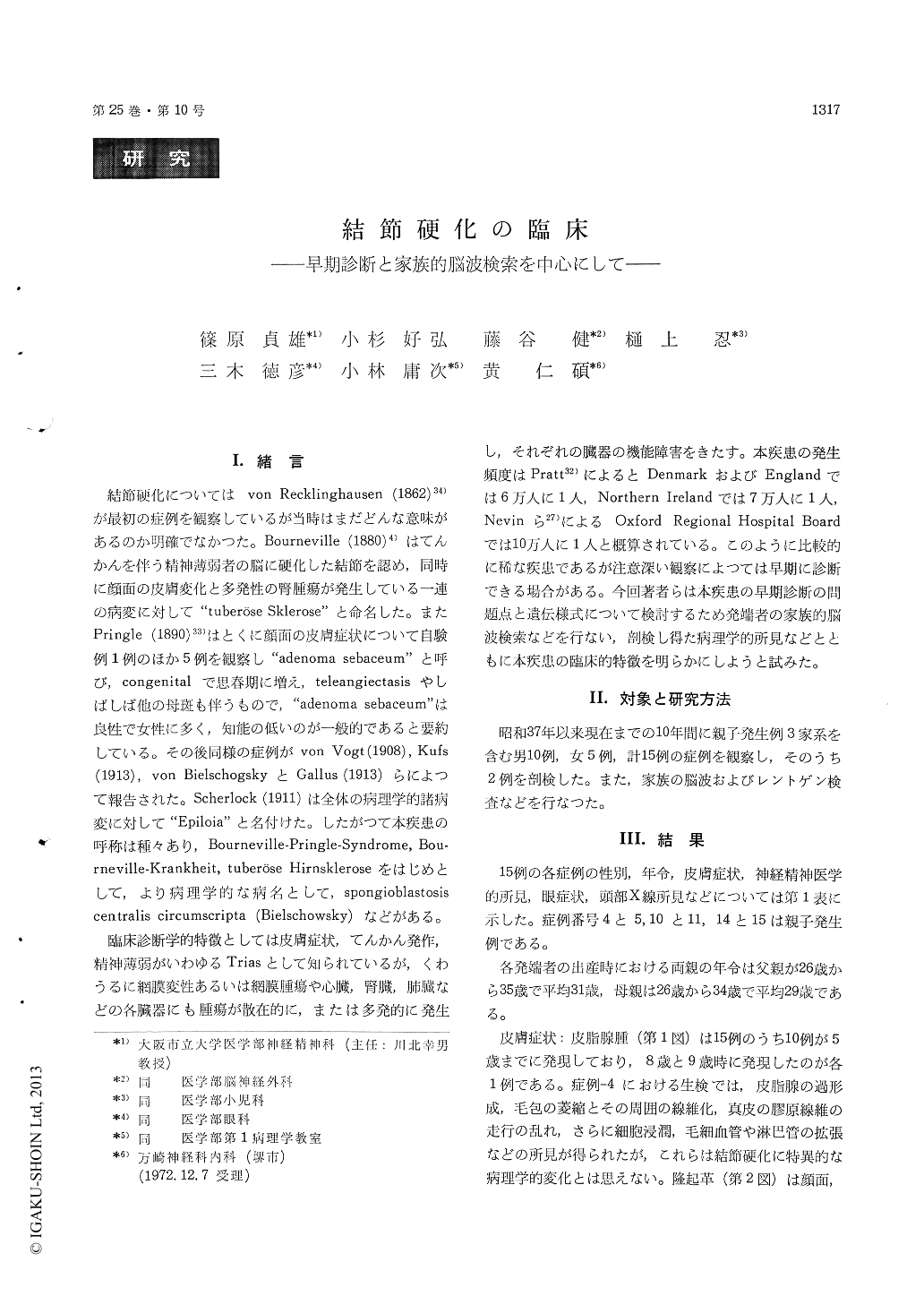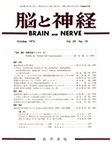Japanese
English
- 有料閲覧
- Abstract 文献概要
- 1ページ目 Look Inside
I.緒言
結節硬化についてはvon Recklinghausen (1862)34)が最初の症例を観察しているが当時はまだどんな意味があるのか明確でなかつた。Bourneville (1880)4)はてんかんを伴う精神薄弱者の脳に硬化した結節を認め,同時に顔面の皮膚変化と多発性の腎腫瘍が発生している一連の病変に対して"tuberöse Sklerose"と命名した。またPringle (1890)33)はとくに顔面の皮膚症状について自験例1例のほか5例を観察し"adenoma sebaceum"と呼び,congenitalで思春期に増え,teleangiectasisやしばしば他の母斑も伴うもので,"adenoma sebaceum"は良性で女性に多く,知能の低いのが一般的であると要約している。その後同様の症例がvon Vogt (1908),Kufs(1913),von BielschogskyとGallus (1913)らによつて報告された。Scherlock (1911)は全体の病理学的諸病変に対して"Epiloia"と名付けた。したがつて本疾患の呼称は種々あり,Bourneville-Pringle-Syndrome,Bou—rneville-Krankheit,tuberöse Hirnskleroseをはじめとして,より病理学的な病名として,spongioblastosiscentralis circumscripta (Bielschowsky)などがある。
臨床診断学的特徴としては皮膚症状,てんかん発作,精神薄弱がいわゆるTriasとして知られているが,くわうるに網膜変性あるいは網膜腫瘍や心臓,腎臓,肺臓などの各臓器にも腫瘍が散在的に,または多発的に発生し,それぞれの臓器の機能障害をきたす。本疾患の発生頻度はPratt32)によるとDenmarkおよびEnglandでは6万人に1人,Northern Irelandでは7万人に1人,Nevinら27)による Oxford Regional Hospital Boardでは10万人に1人と概算されている。このように比較的に稀な疾患であるが注意深い観察によつては早期に診断できる場合がある。今回著者らは本疾患の早期診断の問題点と遺伝様式について検討するため発端者の家族的脳波検索などを行ない,剖検し得た病理学的所見などとともに本疾患の臨床的特徴を明らかにしようと試みた。
Fifteen patients with tuberous sclerosis including three pedigrees suggesting dominant mode of in-heritance.
1) It is important to look for white spots (hypo-pigmented macules) having specific features at birth or in the neonatal period for early diagnosis of tuberous sclerosis. We also support the opinion as some authors suggested that tuberous sclerosis is likely when a combination of white spots and infantile spasms showing hypsarhythmia in EEG. No specific seizure patterns pathognomonic to this disease were observed.
2) From the radiological point of view, cerebral calcification is the commonest and definite mani-festation. This change may be present in the area of the lateral ventricles, often projecting into the ventricle. Therefore pneumoencephalography is useful in establishing the diagnosis.
3) The typical pathological changes are seen in our two cases at autopsy : The brain changes are characterized by scattered hard nodules in the cor-tex and tumors at the wall of the lateral ventri-cles. In the former there appeared chiefly abnormal giant cells and gliosis, in the latter we recognized tumors similar to spongioblastoma or giant cellular astrocytoma associated with calcification, and spin-dle-shaped cells coexist in which hyperplasia of glia fibers whirling or showing regular stream. In addition to these alterations some haeman-giomatous capillary proliferation is observed. In other organs, lipomyoma of the heart, angiolipo-myoma of the kidneies, lipoma of the liver and hamartoma of the lungs are microscopic appea-rance. The pathogenesis based on the pathological pictures is not yet conclusive as the relationship between dysplasia of embryonic connective tissue and pathological changes in nervous system may not well be primarily understood.
4) The mode of inheritance in tuberous sclerosis is considered as irregular autosomal dominant pres-enting various clinical pictures called "pleiotropy", and we suppose one of which is EEG-Abnormality. If we include these formes frustes as a definite manifestation of the disease, the penetrance be-comes much higher. EEG examination of thefamily members is useful to detect these formes frustes.
In our cases, both parents showed normal EEG only one family. It is reasonable to say that the sporadic case without familial occurence may result from mutation. The result of the analysis of our cases is compatible with Gunther and Penrose hypothesis. However, if individuals with abnormal EEG or epileptic patients are included, the findingcannot be explained by the above hypothesis.
5) We could not almost find out significant bio-chemical abnormalities about blood and cerebro-spinal fluid in this disease. Therefore, the relation-ship between such physiological changes as abnor-mal EEG and other biochemical substances on the basis of the pathogenesis of this disease shoud be furthermore investigated.

Copyright © 1973, Igaku-Shoin Ltd. All rights reserved.


